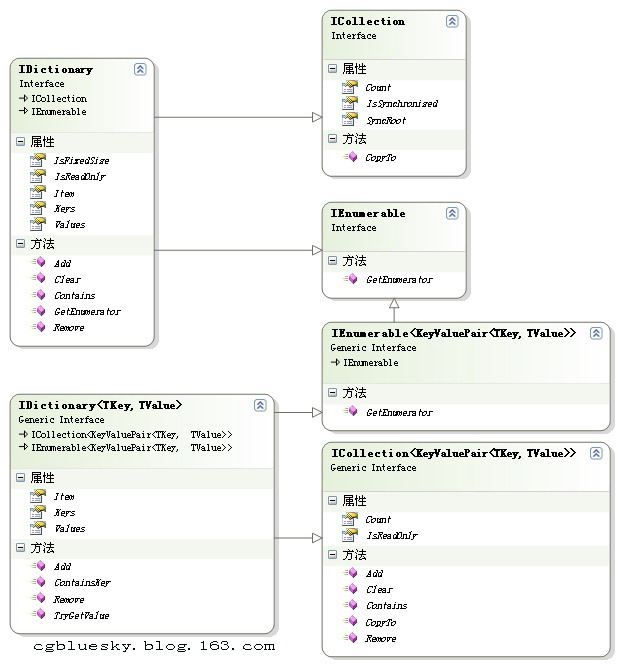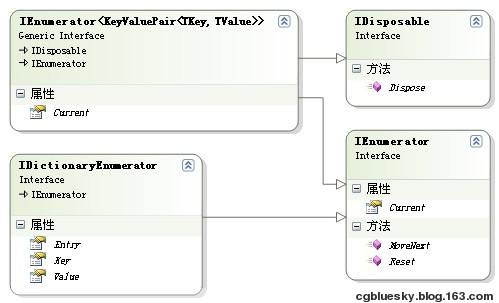构建可反转排序的泛型字典类(5)--实现IEnumerable>接口
5. 实现IEnumerable<KeyValuePair<TKey, TValue>>接口
我们先来看看ReversibleSortedList类的定义:
IDictionary<TKey, TValue>, ICollection<KeyValuePair<TKey, TValue>>,
IEnumerable<KeyValuePair<TKey, TValue>>, IDictionary, ICollection, IEnumerable
它一共实现了6个接口。但从本质上来说,实现IDictionary<TKey, TValue>接口和IDictionary接口就等同于实现了以上6个接口。因为IDictionary<TKey, TValue>继承自ICollection<KeyValuePair<TKey, TValue>>和IEnumerable<KeyValuePair<TKey, TValue>>接口,而IDictionary接口继承自ICollection和IEnumerable接口。下面我们来看一下这些接口的关系图:

图2 ReversibleSortedList类接口关系图
其实ReversibleSortedList类的大部份代码都用于实现左边这两个接口,看到这张图你应该理解了为什么会需要1300行的代码。为了一步一步地实现这个类,我们需要首先实现底层接口,由于ICollection接口本身就继承自IEnumerable接口,所以首先应该实现的是IEnumerable接口。从前面一节可以知道IEnumerable接口的实现需要一个嵌套类,它返回一个枚举器。我们可以为IDictionary<TKey, TValue>接口和IDictionary接口实现同一个枚举器,只要这个枚举器实现了IEnumerator<KeyValuePair<K, V>>接口和IDictionaryEnumerator接口就可以了。前者是IDictionary<TKey, TValue>接口所需要的枚举器,后者是IDictionary接口所需要的枚举器(见前一节)。下面是我们的这个枚举器所需实现的接口的关系图:

图3 Enumerator<K, V>类接口关系图
实现这个类需要注意一个问题,在ReversibleSortedList类中添加了一个新的成员变量:version。在插入元素时(insert方法)会更改这个version值,表示类中的元素已经进行了改动。为什么要使用它呢?在此我做些推测。从MSDN中或许可以找到线索。我们在MSDN找到关于Dictionary<TKey, TValue>类的介绍,这个类跟ReversibleSortedList类非常相似。在关于它的线程安全中有这么一段话:
此类型的公共静态成员是线程安全的。但不能保证任何实例成员是线程安全的。
只要不修改该集合,Dictionary<(Of <(TKey, TValue>)>) 就可以同时支持多个阅读器。 即便如此,从头到尾对一个集合进行枚举本质上并不是一个线程安全的过程。当出现枚举与写访问互相争用这种极少发生的情况时,必须在整个枚举过程中锁定集合。若要允许多个线程访问集合以进行读写操作,则必须实现自己的同步。
可以推测,version用于在枚举过程中判断是否有其他线程更改了ReversibleSortedList实例中存储的元素,以便弹出异常。这一点可以在稍后的代码中看见。
这时可能有人会问了,前面一节中关没有这种判断啊?好,让我们看看上一节关于IDictionary接口的代码。在它的实现枚举器的嵌套类SimpleDictionaryEnumerator中,看看它的构造方法:
{
items = new DictionaryEntry[sd.Count];
Array.Copy(sd.items, 0, items, 0, sd.Count);
}
从代码中可以看出,它把外部类中的所有元素拷贝到另一块内存中进行枚举,这样在多线程访问集合时自然不会出错,但如果集合中的元素很多就会带来性能上的损失。而我们实现的ReversibleSortedList类将直接使用集合中的元素进行枚举,所以需要使用version来保证在出错时可以弹出异常。
下面我们在“ReversibleSortedList 0.3版本”的基础上继续构建。关于version的代码这里不再讲解,请大家查看稍后完整的0.4版本的代码。首先添加一个实现枚举器的嵌套类:
IDictionaryEnumerator, IEnumerator
{
private ReversibleSortedList<K, V> _ReversibleSortedList;
private K key;
private V value;
private int index;
private int version;
internal Enumerator(ReversibleSortedList<K, V> ReversibleSortedList)
{ //获取外部类中的元素引用,以对它进行枚举
this._ReversibleSortedList = ReversibleSortedList;
this.index = 0;
this.version = this._ReversibleSortedList.version;//记录外部类版本号
//设置键和值为其默认类型,请参考:
//http://cgbluesky.blog.163.com/blog/static/2412355820081695340822/
this.key = default(K);
this.value = default(V);
}
public void Dispose()
{
this.index = 0;
this.key = default(K);
this.value = default(V);
}
object IDictionaryEnumerator.Key
{
get
{
if ((this.index == 0) ||
(this.index == (this._ReversibleSortedList.Count + 1)))
{
throw new InvalidOperationException(
"不能进行枚举操作.");
}
return this.key;
}
}
public bool MoveNext()
{
if (this.version != this._ReversibleSortedList.version)
{ //版本检查
throw new InvalidOperationException("枚举版本检查失败!");
}
if (this.index < this._ReversibleSortedList.Count)
{
this.key = this._ReversibleSortedList.keys[this.index];
this.value = this._ReversibleSortedList.values[this.index];
this.index++;
return true;
}
this.index = this._ReversibleSortedList.Count + 1;
this.key = default(K);
this.value = default(V);
return false;
}
DictionaryEntry IDictionaryEnumerator.Entry
{
get
{
if ((this.index == 0) ||
(this.index == (this._ReversibleSortedList.Count + 1)))
{
throw new InvalidOperationException("不能进行枚举操作.");
}
return new DictionaryEntry(this.key, this.value);
}
}
public KeyValuePair<K, V> Current
{
get
{
return new KeyValuePair<K, V>(this.key, this.value);
}
}
object IEnumerator.Current
{
get
{
if ((this.index == 0) ||
(this.index == (this._ReversibleSortedList.Count + 1)))
{
throw new InvalidOperationException("不能进行枚举操作");
}
return new DictionaryEntry(this.key, this.value);
}
}
object IDictionaryEnumerator.Value
{
get
{
if ((this.index == 0) ||
(this.index == (this._ReversibleSortedList.Count + 1)))
{
throw new InvalidOperationException("不能进行枚举操作");
}
return this.value;
}
}
void IEnumerator.Reset()
{
if (this.version != this._ReversibleSortedList.version)
{
throw new InvalidOperationException("枚举版本检查失败!");
}
this.index = 0;
this.key = default(K);
this.value = default(V);
}
}
这个嵌套类的代码对照图3很容易看懂,每个方法的功能在MSDN中也有详细的介绍,这里不再对它进行讲解。接下来要给外部类实现IEnumerable<KeyValuePair<TKey, TValue>>和 IEnumerable接口。更改类声明代码如下:
IEnumerable<KeyValuePair<TKey, TValue>>, IEnumerable
当然,这两个接口分别只有一个成员:GetEnumerator()方法,刚才所创建的嵌套类就是为这个方法所创建的。接下来在ReversibleSortedList类中使用显式接口成员实现来实现这两个接口:
IEnumerable<KeyValuePair<TKey, TValue>>.GetEnumerator()
{
return new Enumerator<TKey, TValue>(this);
}
IEnumerator IEnumerable.GetEnumerator()
{
return new Enumerator<TKey, TValue>(this);
}
{
ReversibleSortedList<int, string> rs=new ReversibleSortedList<int, string>();
rs.Add(3,"a");
rs.Add(1,"b");
rs.Add(2,"c");
rs.Add(6,"d");
rs.Add(5,"e");
rs.Add(4,"f");
foreach (KeyValuePair<int, string> d in rs)
{
Console.WriteLine(d.Key + " " + d.Value);
}
}
由于代码已经达到300行,贴到博客上会导致运行缓慢,后面所有的可运行代码将以文件的形式给出,大家可以直接下载运行。
ReversibleSortedList 0.4版本:实现迭代
单击下载完整代码运行结果:
1 b
2 c
3 a
4 f
5 e
6 d
真棒,现在已经取得了阶段性的成果。但还有一些遗憾,虽然在Enumerator类中实现了IDictionaryEnumerator接口,但还不能在foreach中使用DictionaryEntry访问元素。这是因为IDictionary接口重载了GetEnumerator()接口,而它返回的是一个IDictionaryEnumerator接口,也就是说,只有实现了IDictionary接口才能使用DictionaryEntry访问其中元素。实现IDictionary接口之前我们需要建立一些辅助的内部类,这将在下一节进行讲解。





 浙公网安备 33010602011771号
浙公网安备 33010602011771号